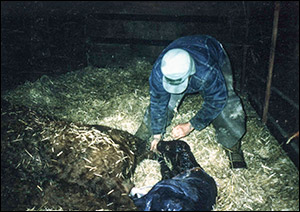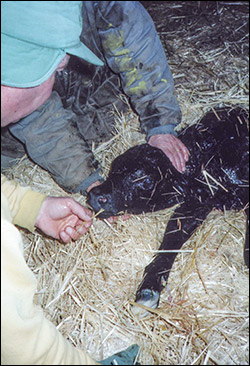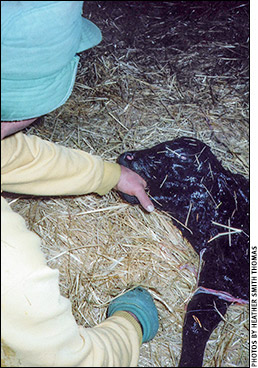First Breaths
Tips for getting a newborn calf to breathe.
In a normal birth, the calf is stimulated to breathe as soon as its umbilical cord breaks and/or its face and nose are uncovered when the amniotic sac comes off its head. Causes for breathing failure include the sac not breaking; a hard birth, leaving the calf exhausted or unconscious from too much pressure for too long; and the placenta detaching too soon.

If it lies flat and hasn’t tried to raise its head, prop the calf up and rub it to stimulate circulation. The calf can breathe better if it is upright; lung function and ribcage movement are impeded when the calf is lying flat.
If the calf doesn’t begin breathing, clear the fluid away from its nose and tickle the inside of one nostril with a clean piece of hay or straw. This usually makes the calf cough and take a breath. If the calf is unconscious and won’t breathe, give artificial respiration.
If a calf was stressed during birth, it may be suffering from acidosis — a pH imbalance caused by a shortage of oxygen, which has an adverse effect on the heart and lungs. One way to tell if a calf is normal or compromised, according to veterinarian Ron Skinner of Drummond, Mont., is whether it tries to raise its head. If it lies flat and hasn’t tried to raise its head, prop the calf up and rub it to stimulate circulation. The calf can breathe better if it is upright; lung function and ribcage movement are impeded when the calf is lying flat.
How you pull a calf makes a difference. Pull when the cow is straining and rest when she rests. Don’t use steady traction without this periodic rest. It takes time for the cervix to dilate and the birth canal to stretch.

If the calf doesn't begin breathing, clear the fluid away from its nose and tickle the inside of one nostril with a clean piece of hay or straw.
“A cow doesn’t squirt a calf out in two minutes with a normal birth. She’ll get up and down, and push and rest. The calf will make progress as she strains, then go back in a little. The cow keeps stretching more, gets up and walks around and lies back down. Take your time; if you only pull as the cow pushes, you only have to pull half as hard to get as much done. When she’s not pushing, let the calf back,” says Skinner.
If you pull constantly, there is constant pressure on the calf, impairing circulation.
“This is one reason some calves are unconscious and fail to start breathing,” Skinner says. “If he’s really tight in the birth canal and you are constantly pulling on his legs that are tight against his head, they are putting pressure against his jugular vein.
“When I have a tight one, I’ll pull when the cow pushes, four or five times, and then I’ll push the calf back, to let him get some circulation to his head,” he continues. “After giving the cow a little time to rest, with the calf pushed back inside a bit (like she’d be doing out in the field when she gets up and walks around), I’ll pull again.”
Once the calf’s head is out to his eyebrows, it is ok to pull the calf out because the cow is now stretched enough, Skinner says, adding that the calf will then usually start to breathe.

If the calf’s heart is still beating, you can give artificial respiration. Use your fingers to strip fluid from the calf’s mouth and nose in a suction-like action. You can also use a suction bulb.
“With most calves that don’t start breathing, we’ve impaired the circulation to their heads too long. The dropping level of oxygen in the blood (when the umbilical cord breaks) triggers the brain to tell the calf to breathe, but if we’ve been pulling with constant pressure, we’ve cut circulation to the brain enough that this trigger isn’t happening, and he won’t breathe,” says Skinner.
If the calf’s heart is still beating, you can give artificial respiration. Use your fingers to strip fluid from the calf’s mouth and nose in a suction-like action. You can also use a suction bulb.
Lay the calf on its side with head and neck extended. Cover one nostril with your hand, holding its mouth shut (to prevent air escaping) and gently blow a full breath into the other nostril. Don’t blow too forcefully or you might rupture a lung.
Blow until you see the chest rise. Then let the air come back out. Blow in another breath until the chest rises again. Continue filling the lungs and letting them empty, until the calf starts breathing on its own. Usually, once the body tissues become less starved for oxygen, the calf will regain consciousness, and start to breathe.

Editor’s Note: Heather Smith Thomas is a freelancer and cattlewoman from Salmon, Idaho.





